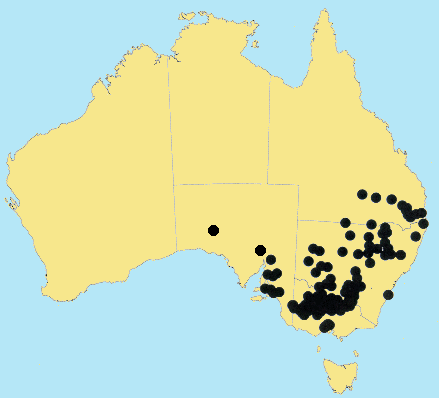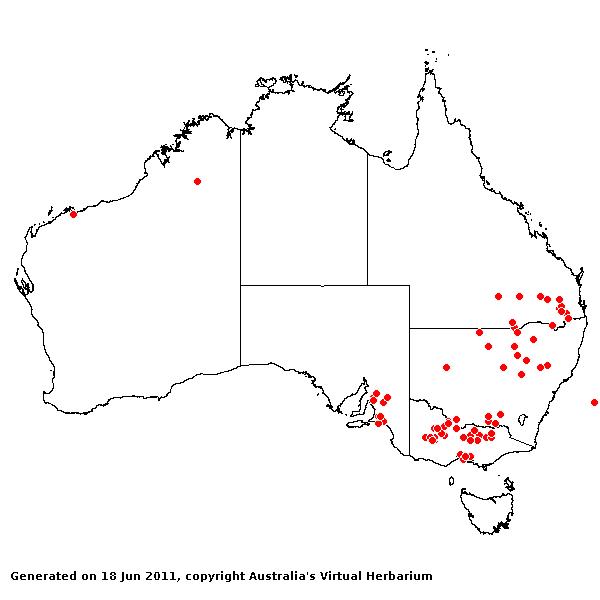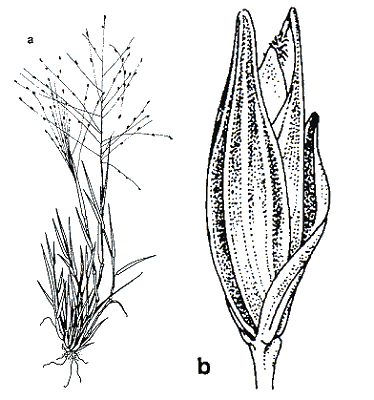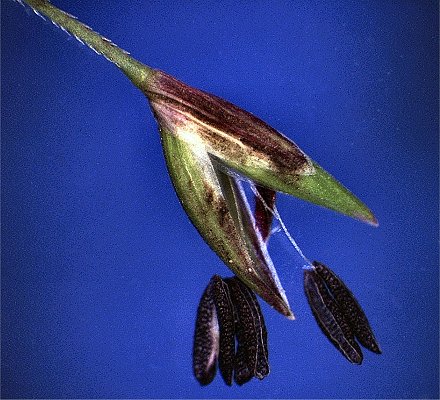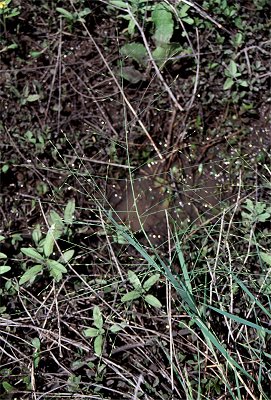Walwhalleya proluta (F. Muell.) K.E. Wills & J.J. Bruhl. Aust. Syst. Bot. 19: 327 (2006).
Classification. (GPWG 2001) : Subfamily Panicoideae. Paniceae.
Basionym and/or Replacement Name: Panicum prolutum F.Muell., Trans. & Proc. Victorian Inst. Advancem. Sci. 1854/1855: 46 (1855).
Type of Basionym or Protologue Information: HT: F. von Mueller s.n., Australia: Victoria: Avoca River (MEL; IT: K).
Recent synonyms: Homopholis proluta, Whalleya proluta.
Key references (books and floras): [1878] G.Bentham, Flora Australiensis 7 (490 as Panicum prolutum), [1952] C.A.Gardner, Flora of Western Australia 1 Gramineae (257 as Panicum prolutum), [2002] D.Sharp & B.K.Simon, AusGrass, Grasses of Australia, [2006] J.Jessop, G.R.M.Dashorst, F.M.James, Grasses of South Australia (495 as Whalleya), [2008] S.W.L.Jacobs, R.D.B.Walley & D.J.B.Wheeler, Grasses of New South Wales (400).
Illustrations: [2006] J.Jessop, G.R.M.Dashorst, F.M.James, Grasses of South Australia (494, fig. 426 as Whalleya), [2008] S.W.L.Jacobs, R.D.B.Whalley & D.J.B.Wheeler, Grasses of New South Wales, 4th edn (400).
Habit. Perennial. Stolons absent. Culms erect, 20–100 cm tall, wiry, 5 -noded. Lateral branches simple or sparsely branched. Leaf-sheaths smooth or scaberulous. Leaf-sheath auricles present. Ligule an eciliate membrane, 1.5–4 mm long, truncate or obtuse. Leaf-blades flat, 2–20 cm long, 2–7 mm wide. Leaf-blade surface smooth or scaberulous or scabrous.
Inflorescence. Inflorescence compound, a panicle. Panicle ovate, effuse, 10–28 cm long.
Spikelets. Spikelets pedicelled. Fertile spikelets 2-flowered, the lower floret barren (rarely male), the upper fertile, comprising 1 basal sterile florets, comprising 1 fertile floret(s), without rachilla extension, lanceolate or elliptic, dorsally compressed, 3–4 mm long.
Glumes. Glumes thinner than fertile lemma. Lower glume elliptic or oblong or ovate, membranous, much thinner on margins, without keels, 3–5 -nerved. Upper glume elliptic, 3–3.6 mm long, membranous, without keels, 7(–9) -nerved. Florets. Basal sterile florets 1, barren, without significant palea. Lemma of lower sterile floret 100 % of length of spikelet, membranous, 7 -nerved.
Fertile lemma 1.9–2.5 mm long, without keel. Lemma surface indumented. Anthers 3.
Continental Distribution: Australasia.
Australian Distribution: South Australia, Queensland, New South Wales, Victoria.
South Australia: Flinders Ranges, Eyre Peninsula, Northern Lofty, Murray, Yorke Peninsula, Southern Lofty, South-eastern. Queensland: Darling Downs, Maranoa, Warrego. New South Wales: North Coast, North-Western Slopes, Central-Western Slopes, South-Western Slopes, North-Western Plains, South-Western Plains, North Far Western Plains, South Far Western Plains. Victoria: East Gippsland, Murray Mallee, Riverina, Volcanic Plain, Wimmera.
Notes. Homopholis proluta has in common with H. belsonii the the overall form of the inflorescence, a membranous ligule, pronounced raised nerves on the lower lemma, and the C3 leaf anatomy. It is closer allied to H. belsonii than the Panicum species.
In dry sclerophyll forests, temperate sub-humid woodlands, semi-arid shrub woodlands, shrub steppe shrublands, acacia shrublands, and eucalypt shrublands. Flowers Oct.-May.
